Leasing and drilling activity are gaining due to prospects for producing higher-priced liquids in addition to dry gas.
Pramod Kulkarni, Editor
Shale plays have changed the landscape of the US oil and gas industry. While the Barnett, Marcellus and Haynesville Shales offer potential gas reserves measured in trillions of cubic feet, activity in these regions has been subdued somewhat due to low gas prices in the range of $4–5/Mcf. Consequently, many operators are turning their attention to the Eagle Ford Shale, which offers opportunities for the production of higher-priced condensate, natural gas liquids and crude oil, Fig. 1. The lucrative nature of the Eagle Ford has been confirmed through the arrival of multinational oil companies such as Shell, BP and ConocoPhillips via joint ventures and mergers as well as the direct leasing of acreage, particularly in the Eagle Ford condensate and oil windows.
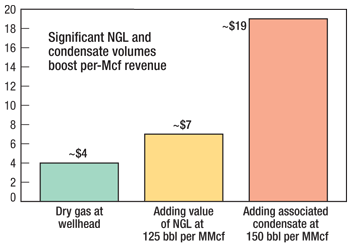 |
|
Fig. 1. Additional production of NGLs and condensate can increase potential revenue from $4/Mcf for dry gas to as much as $19/Mcf and increase the rate of return from 10% to 50% or greater. Courtesy of El Paso Corporation.
|
|
GEOLOGICAL SETTING
The Eagle Ford Shale extends in the shape of a crescent band across South Texas from the border with Mexico to East Texas. It is about 50 mi wide and 400 mi long, Fig. 2. Located in Cretaceous strata, the shale is found at an average depth of 11,000 ft and varies in thickness from 100 ft to 330 ft. In terms of stratigraphy, the Eagle Ford Shale is located below the Austin Chalk and above the Buda limestone, and serves as the source rock for the Austin Chalk and East Texas oil and gas fields, Fig. 3. Core samples from the Eagle Ford Shale have contained up to 70% calcite and 11% clay content, indicating a brittle, highly permeable rock with low water affinity, Table 1.
As such, the Eagle Ford Shale is easier to fracture than shales in Barnett and Marcellus, but greater shale thickness requires additional stimulation.
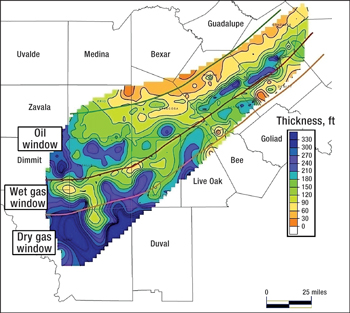 |
|
Fig. 2. The Eagle Ford Shale play extends across South Texas and has distinct updip oil, mid-dip gas/condensate and downdip dry gas windows. The shale thickness can be as much as 330 ft. Courtesy of EOG Resources.
|
|
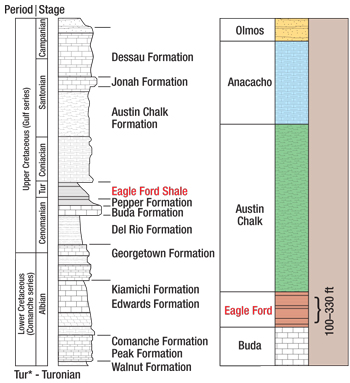 |
|
Fig. 3. The Eagle Ford Shale is located between the Austin Chalk and Buda limestone formations.
|
|
| TABLE 1. Eagle Ford reservoir profile |
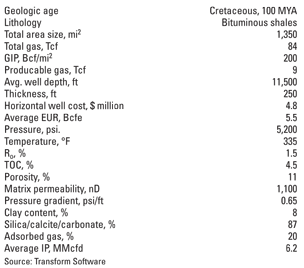 |
The US Geological Survey (USGS) has yet to make reserves estimates for the Eagle Ford, but Transform Software estimates the total gas in place to be 84 Tcf, with a typical well EUR of 6 Bcf of gas equivalent. The trend is overpressured and yields high production rates followed by rapid decline. Petrohawk Energy drilled the first Eagle Ford well in 2008, discovering Hawkville Field in La Salle County, Fig. 4. The discovery well flowed 7.6 MMcfd and 250 bpd of condensate from a 3,200-ft lateral with 10 facture stages. The first perforation was located at 11,141 ft TVD.
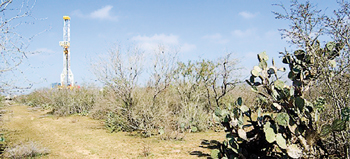 |
|
Fig. 4. Energy was the first to drill in the Eagle Ford and currently holds 360,000 acres in the play.
|
|
LEASING ACTIVITY
Nearly 5 million acres in the Eagle Ford area has been leased thus far, Table 2. Prices paid by the operators have ranged from as low as $50/acre in the early days to a current range of $200 to $4,500/acre. Leasing rates are higher in the oil and condensate windows, where there is stiff competition among operators. BP is reported to have paid $1,500/acre as part of its joint venture with Lewis Energy. Petrohawk paid an average of $200/acre for 87,000 net acres in its Red Hawk Field, less than $400/acre for 228,000 net acres in Hawkville Field and $3,000/acre for the condensate-rich Black Hawk Field. Rising demand in the liquids-rich areas is pushing up lease bonuses to $10,000/acre.
| TABLE 2. Eagle Ford acreage positions |
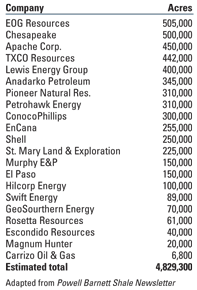 |
COMPANY OPERATIONS
Since 2008, drilling and delineation activity has been carried out primarily by small US independents such as EOG Resources, Pioneer Natural Resources and Petrohawk Energy. Large independents such as Chesapeake and majors such as BP, Shell and ConocoPhillips are acquiring partners and acreage and will steadily increase their activity, particularly in the oil and wet gas windows.
EOG Resources, the US independent oil and gas company, is the leading lease holder in the Eagle Ford play with 505,000 net acres in the premium oil window, 26,000 acres in the condensate window and 49,000 acres in the dry gas window. EOG is operating a six-rig drilling program. Its current production is about 6 million boepd, with plans to steadily increase production to 185 million boepd by 2016.
Chesapeake Energy increased its acreage position in the Eagle Ford Shale to 500,000 net acres by the first quarter of 2010. Unlike its aggressive campaigns in the Barnett and Marcellus plays, Chesapeake is just now proving its Eagle Ford resources through two drilling rigs. The company has completed three gross wells to date, and estimates that it will average four rigs during 2010 to drill 40 net wells. Chesapeake estimates its unrisked, unproved resources to be 11 Tcfe.
Apache has acquired 450,000 acres in the Eagle Ford area. Its Briscoe Apache Ranch 1H well was drilled to a 7,900-ft TVD and a 4,000-ft lateral, and completed with a 14-stage hydraulic fracturing operation. The well had a seven-day maximum production rate of 7.1 MMcfed.
TXCO Resources holds 440,000 net acres and has carried out limited drilling activities. The company has 1,950 net drilling locations in 489 net sections with an expectation of 80–110-Bcf production per section. TXCO Resources has sold its interest in 239,000 acres in the Eagle Ford to Newfield Exploration, which launched a multi-rig program in June 2010 at a cost of $100 million. TXCO also has joint ventures with Anadarko and St. Mary Land & Exploration.
Lewis Energy Group holds 400,000 acres in the Eagle Ford. In March 2010, BP announced a $160 million joint venture with the small South Texas operator. BP will assume a 50% stake in 80,000 acres in the southeastern portion of the play at a price of $4,000–$4,500/acre. The two companies are operating one drilling rig in the play and are expected to add three more rigs by the end of 2010. Last year, Lewis produced more than 66.35 MMcfd, with most of the production coming from Webb County.
Anadarko Petroleum has 345,000 net acres under lease in the Eagle Ford Shale, and has identified future drilling locations. During the first quarter of 2010, the company added 80,000 net acres at an approximate cost of $1,100 per acre from TXCO to increase its working interest to 75% across all of its Eagle Ford acreage. Anadarko is running four rigs with upcoming expansion to six rigs, and has drilled more than 20 wells in the play. Its EUR per well is 300 million boe.
Petrohawk Energy has 360,000 net acres in the Eagle Ford Shale, of which 225,000 acres are in the oil window. While Petrohawk has cut its overall budget in 2010 by $100 million to $1.35 billion, it has shifted capital spending from the Haynesville to the Eagle Ford. The company’s Eagle Ford spending is now $390 million to support an eight-rig operation in its three fields: Hawkville, Black Hawk and Red Hawk.
Pioneer Natural Resources holds 310,000 gross acres in the Eagle Ford Shale, with about 70% of the acreage located in the condensate window. Based on the analysis of 2,000 sq mi of 3D seismic data, proprietary core samples and successful drilling results, Pioneer has identified 1,750 drilling locations. Pioneer’s Handy Gas Unit 1 well, located in Karnes County, tested at an IP rate of 7.7 MMcfd and 2,030 bpd of condensate. The well was drilled to a vertical depth of about 13,100 ft and completed in a 4,400-ft lateral section with a 12-stage fracture stimulation. Pioneer is planning to aggressively increase its drilling activity from the current two rigs to six or seven rigs by the end of 2010, ten rigs by the end of 2011 and 14 rigs by the end of 2012.
ConocoPhillips has leased about 300,000 acres in the Eagle Ford play at a relatively low cost of $300/acre. It is operating six to eight drilling rigs. One of its wells, Bordovsky A-7, had an IP rate of 3.8 MMcfd and 1,200 bcpd.
Shell had acquired 250,000 net acres in the liquids-rich window of the Eagle Ford by the end of May 2010. Shell will be the operator in this highly contiguous acreage, and plans to integrate these assets into its existing South Texas conventional oil and gas operations.
Murphy Exploration & Production entered the play in March 2009 by acquiring 201,289 acres at an average $825/acre. Murphy plans to spend $124 million in 2010 with a two-rig program. The company is planning to increase production from its current 3 MMcfed to over 300 MMcfed by 2015. According to Murphy’s analysis, its breakeven cost for the Eagle Ford wells is $3.30/Mcf.
St. Mary Land & Exploration has 165,000 net acres with 100% working interest in the Eagle Ford and 84,500 additional acres in a joint venture with Anadarko. St. Mary began building its acreage in 2007 and paid an average of $250/acre. The company increased its 2010 Eagle Ford budget by $68 million to $284 million to support two rigs on its operated acreage and is planning to drill 34 gross wells during 2010.
El Paso has acquired 150,000 net acres in the Eagle Ford and has identified 700 drilling locations in both the condensate and dry gas windows. It is currently running a two-rig drilling program. El Paso’s second well had an IP rate of 2.9 MMcfd and 721 bcpd.
Hilcorp Energy has 100,000 net acres in the Eagle Ford and is running two rigs to explore and delineate its properties. In June 2010, the privately held company announced a joint venture agreement with Kohlberg Kravis Roberts (KKR) worth $400 million. KKR will receive a 40% stake in the company. Hilcorp may acquire additional acreage as a result of this investment.
Swift Energy owns 75,000 net acres in the Eagle Ford in McMullen, La Salle and Web Counties. The operator has current production of 50 MMcfed and plans to drill and complete 15 wells during 2010.
Talisman Energy, the Canadian independent, has acquired 37,000 net acres in the liquids window of the play with 2,000-boepd production. Talisman Energy paid $360 million for the acreage and plans to use one rig to drill seven wells starting in June 2010. Talisman will spend up to $50 million per year over the next three years to hold its acreage and expects to ramp up production to about 300–350 MMcfd at a breakeven cost below $4/Mcf.
Rosetta Resources has acquired 61,000 net acres in the Eagle Ford since 2008. In 2009, Rosetta drilled four wells to evaluate the lease. Each well had 4,000-ft laterals and 10-stage fracture treatments. During the first quarter of 2010, Rosetta spudded nine horizontal wells. Seven wells have been drilled to TD, and two wells have been completed. The lateral length of the seven drilled wells averaged about 4,700 ft. Three of the seven drilled wells were fracture-stimulated during the first quarter using 13–15 frac stages per well. The gross seven-day rate on the two recently completed and producing wells averaged 3.2 MMcfd of gas, 350 bcpd and 490 bpd of NGL, for a total of over 8.2 MMcfed per well.
Cabot Oil & Gas has leased 52,000 net acres in the Eagle Ford oil window to increase exposure to liquids. Cabot’s first well had a 3,000-ft lateral with a 14-stage frac job and is producing 334 bopd and 142 Mcfd. The company is planning to drill four more wells during 2010.
Goodrich Petroleum recently acquired 35,000 net acres in the Eagle Ford for a total consideration of $1,675/net acre within the oil window of La Salle and Frio Counties. For 2010, Goodrich has allocated $50 million for leasehold, drilling and completion costs in the play. As of this writing, the company expects to spud its initial Eagle Ford Shale well late in the second quarter and run one to two rigs in the play during the second half of the year, with a goal to spud seven or eight Eagle Ford Shale wells during 2010.
MERGERS AND ACQUISITIONS
In March 2010, BP made a joint venture deal with privately held Lewis Energy Group to take a 50% stake in 80,000 acres in the Eagle Ford. BP is expected to announce additional deals to acquire Eagle Ford acreage in the coming months.
Pioneer Natural Resources, which has drilled wells with some of the highest IP rates in the Eagle Ford, announced a joint venture in late June 2010 with India-based Reliance Industries to develop core Eagle Ford acreage, 70% of it in the condensate window. Under the agreement, Reliance will pay $1.315 billion to acquire a 45% interest in Pioneer’s acreage, and will have an option to acquire a 45% share in future Pioneer acreage acquisitions in the play. Reliance previously bought into the Marcellus Shale by paying $1.7 billion for a 40% position in Atlas Energy’s core acreage there.
Chesapeake Energy is also seeking a partner to develop its Eagle Ford acreage. CEO Aubrey McClendon has said the company could use the same horizontal drilling techniques it has used to produce natural gas from shale to produce crude oil. Chesapeake hopes to reach a joint venture deal by mid-2010.
Magnum Hunter has formed a 50% joint exploration and operating agreement with Hunt Oil for its 26,822 net Eagle Ford acres in Gonzales and Lavaca Counties. The partners will drill two exploratory wells. Magnum Hunter has allocated $30.7 million for Eagle Ford activity—$10.6 million of it for drilling three horizontal wells.
REGIONAL STUDIES
Several operators, such as Pioneer, are using proprietary 3D seismic data that had been acquired previously to target the Edwards Chalk. Using the data, it is possible to develop drilling plans to target both the Edwards and Eagle Ford Formations. Global Geophysical Services is currently acquiring a 1,500-sq-mi multiclient 3D survey. Global’s processing package includes the FracFactor service, which can help delineate ductile and brittle zones in the shale section.
Core Laboratories is developing a multi-company regional study on the Eagle Ford Shale. The study includes characterization and evaluation of rock properties based on conventional and rotary sidewall cores and rock cuttings. This data has been combined with well logs, stimulation designs and production information to develop an integrated study of geological, petrophysical, geomechanical, geochemical and production properties.
In College Station, Texas, Schlumberger is following up on work in other shale plays by using Petrel seismic-to-simulation software to define the Eagle Ford’s petrophyscial properties.
DRILLING ACTIVITY
Eagle Ford drilling activity covers the Texas Railroad Commission’s Districts 1, 2 and 4, Fig. 5. Since the downturn of 2009, the rig counts in all three districts have exhibited a steady increase. Much of the drilling and completion activity is focused in the oil and condensate windows, Fig. 6.
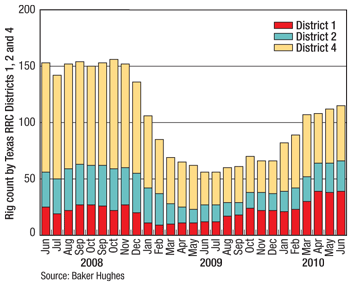 |
|
Fig. 5. Eagle Ford rig count across Texas RRC Districts 1, 2 and 4.
|
|
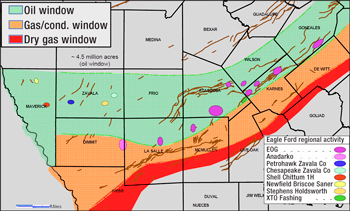 |
|
Fig. 6. Eagle Ford drilling and completion activity is currently concentrated in the oil and condensate windows. Courtesy of Cabot Oil & Gas.
|
|
Most operators drill vertically between 5,500 ft and 11,000 ft and then drill laterals of 3,500–5,000 ft. The wells are fraced with either slickwater or acid in at least 10 stages. Petrohawk’s first Eagle Ford well cost $14 million and required 60 days from spud to TD. Subsequently the company has streamlined its drilling operations to reduce drilling days to about 17 and cost down to an average of $5–6 million, Fig. 7.
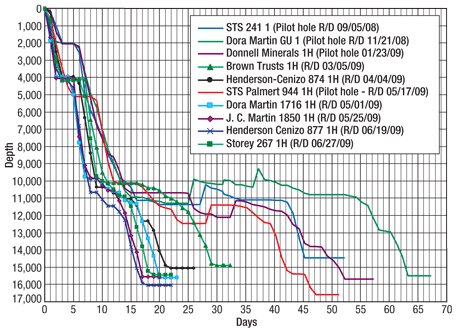 |
|
Fig. 7. Petrohawk Energy has reduced drilling days for its Eagle Ford wells from an initial 67 days to as little as 17 days.
|
|
Some operators are using rotary steerable systems (RSS) to drill the build and lateral sections. The use of RSS systems, such as Schlumberger’s PowerDrive X5 system or the Baker Hughes’ AutoTrak system, enables full weight on the bit and eliminates the need to create a smooth hole through back-reaming. The azimuthal LWD images are used to place the well in zones as tight as 8 ft. Staying in the sweet spot also improves drilling efficiency. On one Eagle Ford well, Schlumberger’s Power Drive vorteX powered RSS realized an average rate of penetration (ROP) of over 107 ft/hr and drilled with downhole rotational speed of 220 rpm or greater.
Weatherford applied its directional drilling service in the Eagle Ford for a major operator in La Salle County. The company’s pulse-directed steering (PDS) technology performed without incident and drilled from a depth of 3,691 ft to 8,100 ft in one run, at an average ROP of 149 ft/hr. This job was the world’s first vertical control/nudge drilling application that was completed with a conventional mud motor/MWD bottomhole assembly. The company’s proprietary Revolution RSS was then run, kicking off from vertical at 8°/100 ft with no issues and then landing the curve according to the well plan. Continuing to drill the lateral section with the RSS averaging more than 100 ft/hr, Weatherford reached TD at a lease hard line of 14,874 ft MD and provided an extended lateral section to the planned wellbore. The performance on this job cut four days off the operator’s planned drilling AFE.
FORMATION EVALUATION
Back in 1979, a landmark technical paper suggested the use of gamma ray spectral data for the evaluation of fractured shale reservoirs and source rock characteristics.1 The authors published scanning electronic microscope images of Eagle Ford Shale samples and demonstrated how spectral gamma ray logging may be used to evaluate organic-rich shales. Currently, Schlumberger offers elemental capture spectroscopy for accurate clay and carbonate estimations. Core information is combined with the latest combinable magnetic resonance (CMR) processing, resulting in high-quality carbonate imaging.
FRACTURING
Fracturing Eagle Ford wells is complicated by the heterogeneity of the play. Some shale areas are dry and others wet. Some areas are hot and deep and others are not. Tom Royce, BJ Services’ region technology manager in South Texas, says stimulation designs vary more across the Eagle Ford than in any other play: “They have a single recipe; we have a whole cookbook.” Throughout the play, a variety of proppants are used: sand, ceramic and even bauxite. Frac fluids include linear gel or crosslinked, low-polymer fluid. BJ’s StimPlus services have been used to extend conventional fracture stimulation by adding proprietary Sorb solid inhibitors to protect against scale, paraffin, corrosion and/or asphaltene problems. In addition, said Karl Winfield, BJ Services’ South Texas district manager for chemical services, capillary tubing-injected corrosion and scale inhibition chemicals are increasingly important, along with foamers to maximize production in the wetter areas of the play.
Although a few operators have experimented with frac sleeve systems, most wells are plug-and-perf completions, which typically require 2-in. coiled tubing to mill out the plugs and clean the long, horizontal laterals for production. A final trend worth noting is that “cost is beginning to affect design,” Royce said. Whereas early Eagle Ford wells were pumped at 60–80 bbl/min., more recent wells are either reducing the rate and using crosslinked fluids or increasing the rate to 100 bbl/min. and trying to fracture more perforation clusters per stage.
Schlumberger offers the Sonic Scanner acoustic scanning platform service to better understand the 3D stress regimes due to shale layering. The tool provides information on various stress barriers to develop optimum frac design and zone placement. Subsequent to fracing, Schlumberger can provide StimMap real-time microseismic fracture monitoring service to help evaluate frac propagation and treatment effectiveness.
Water used for drilling and fracturing Eagle Ford wells originates from the Carrizo-Wilcox aquifer. This source also supplies municipal water to the cities in the region and for industrial applications such as lignite processing. While the aquifer is being recharged at a slower rate than the discharge, the situation has not reached a crisis state. A water well drilled by an operator for drilling and fracturing is typically turned over to the local rancher after use. The Texas Railroad Commission governs the rules for disposal wells to inject produced water into the formation below the water table.
PROCESSING AND PIPELINE TAKEAWAY
The liquids-rich Eagle Ford hydrocarbon stream requires regional processing facilities. Copano, DCP, Enterprise and Kinder Morgan have combined wet gas pipeline capacity of 3 Bcfd to transport the current production levels. A fractionation unit in Mont Belvieu has 700,000-bpd capacity with proposed expansion to 900,000 bpd to handle NGL production. Refineries in the region have the capacity to process existing production of condensates: Corpus Christi (725,000 bpd), Port Arthur (950,000 bpd) and Houston (more than 2 million bpd).
Enterprise has announced a letter of intent to construct a 140-mi crude oil pipeline originating in Karnes County, Texas, and connecting to Pioneer’s existing crude oil system in Austin County. Enterprise is also in discussions with a number of other producers to provide crude oil transportation services through additional connections to the pipeline. When completed in the fourth quarter of 2011, Enterprise’s crude oil pipeline system will provide access to the refining markets in the Houston area, as well as the major storage hub in Cushing, Oklahoma, through the Enterprise-operated Seaway pipeline. Enterprise is also constructing central delivery points in Karnes and Gonzales Counties to receive crude oil from gathering lines and trucks.
Kinder Morgan and Copano have formed a joint venture to provide gathering, transportation and processing services to natural gas producers in the Eagle Ford. They have each increased their committed capacity from 150,000 to 375,000 MMBtupd for transportation on Kinder Morgan’s Laredo-to-Katy pipeline and processing at Copano’s Houston central processing plant.
CONTINUED GROWTH
Considering that the Eagle Ford Shale play was discovered only in 2008, it has gained the attention of both US independents and majors due to the attractiveness of producing liquids in addition to natural gas. Due to its proximity to pipeline networks and processing facilities, it will continue to be a center of drilling and production activity even when natural gas prices improve.
One of the important factors favoring the Eagle Ford is the region’s oil and gas culture. South and Central Texas have seen oil and gas operations in their proximity for decades. Working in the Eagle Ford beats contending with unfamiliar or even hostile community environments in other regions of the US. Nevertheless, operators must be careful with water usage and attend to all the requisite safety and environmental standards. 
LITERATURE CITED
1 Fertl, W. H. and H. H. Rieke III, “Gamma ray spectral evaluation techniques identify fractured shale reservoirs and source rock characteristics,” SPE 8454 presented at the SPE Annual Technical Conference and Exhibition, Las Vegas, Nevada, Sept. 23–26, 1979.
|











